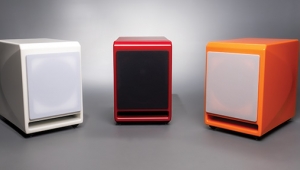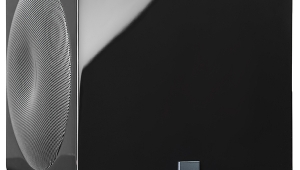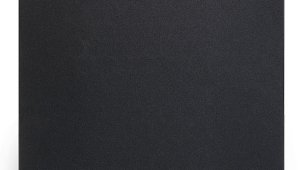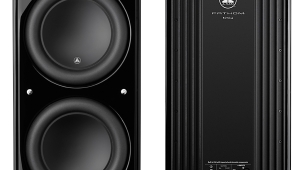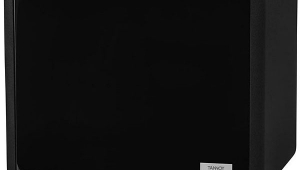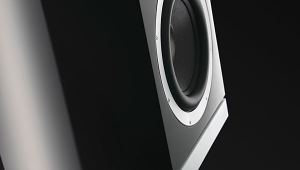| Columns Retired Columns & Blogs |
Velodyne Digital Drive DD-18 powered subwoofer Page 2
Setup
I unpacked and shoved the DD-18 across the living room to a spot along the rear wall, between the Quads. These speakers were positioned 5' from the rear wall, 8' apart, 3' from the side walls, and toed-in slightly. My listening chair faced this short wall of my lightly damped, rectangular, 4056-cubic-foot listening room. (The room is 26' long, 13' wide, and 12' high. Behind the listening chair, the other end of the room opens into a 25' by 15' by 8' kitchen.) I set up the calibration microphone on the back of my listening chair at my seated ear height of 37".
Footnote 2: The warble tones on Editor's Choice (STPH016-2) are better for this purpose, in that the warble rate is lower and I cleaned up each warble tone by filtering out distortion.—John Atkinson
I unpacked and shoved the DD-18 across the living room to a spot along the rear wall, between the Quads. These speakers were positioned 5' from the rear wall, 8' apart, 3' from the side walls, and toed-in slightly. My listening chair faced this short wall of my lightly damped, rectangular, 4056-cubic-foot listening room. (The room is 26' long, 13' wide, and 12' high. Behind the listening chair, the other end of the room opens into a 25' by 15' by 8' kitchen.) I set up the calibration microphone on the back of my listening chair at my seated ear height of 37".
Wiring the DD-18 was straightforward. I ran a single RCA cable from the sub's composite-video output to the video input of my TV, which took up residence atop the DD-18 during setup. To convey the DD-18's sweep-tone signal, I ran the supplied 25' RCA interconnect from the DD-18 service panel's EQ Left/Right output jacks to the preamp's Tape input.
I then moved the DD-18 around to find the best place for it. I tried it in three positions—center of rear wall, midway between center and one of the corners, and in the corner—then tested each position with the Velodyne's sweep signal, watching the results on my TV. I had to adjust the DD-18's output to its lowest setting to match the output of the Quads driven by my Mark Levinson ML-2 monoblocks.
At each location, I checked the DD-18's unequalized frequency response in my room, beginning at the center of the rear wall (fig.3). The sweep signal revealed a curve with prominent peaks at 40 and 80Hz and deep valleys at 32 and 50Hz. This meant that I had to move the sub. I got the best results when I moved it into the corner, where the unequalized sweep signal showed two lower peaks and two shallower valleys. While the sweep-signal tones sounded tighter and more solid with the DD-18 in the corner, these effects were subtle.

Fig.3 Quad ESL-989 with Velodyne DD-18 in center of front wall, no equalization, in-room response (25dB vertical range).
I then equalized the corner-placed DD-18's output to flatten its response, achieving a relatively "flat" curve (±4dB) from 25 to 200Hz (fig.4). The remote volume was set to "1," the low-pass crossover point to 80Hz, the subsonic filter to 15Hz, and phase to "0." I verified this setup using the 1/3-octave warble tones on Stereophile's Test CD (STPH002-2) (footnote 2). The overall system's volume was such that the 100Hz output registered 0dB on my RadioShack SPL meter.

Fig.4 Quad ESL-989 with Velodyne DD-18 in room corner, equalized for flattest in-room response (25dB vertical range).
I experimented with the DD-18's settings during the equalization phase of setup. With the low-pass filter set to 70Hz, a prominent frequency-response valley opened up as the high- and low-pass filters' rolloffs no longer summed complementarily. Moving the low-pass filter's crossover point up to 120Hz produced a huge peak at 100Hz, as the Quads and the Velodyne now overlapped in that range.
I could smooth response peaks by lowering the Q value of the parametric equalizer bands on the display, which broadened the actions of these filters. I then tried applying boost to eliminate a room-node valley. This was more difficult. While the DD-18's equalizer is capable of 12dB cuts, it will apply a boost of, at most, 6dB. Trying to fill in the "black hole" of a cancellation-induced room node can't be done, and any attempt to do so might well push the DD-18's amplifier beyond its limits. It was better, I discovered, to fill in the response valleys by moving the subwoofer.
Music
Once level-matched and equalized, the DD-18 proved to be an awesome subwoofer, producing tight, solid, bass reinforcement for my system. The from the combo of Quad ESL-989s and DD-18 had pitch definition, mass, and speed. I heard jaw-dropping increases in definition in the deepest notes. This was true for the subterranean synthesizer passages in several tracks from the Patriot Games soundtrack (CD, RCA 66051-2)—"Main Title," "Attempt on the Royals," and "Assault on Ryan's House"—as well as in the depiction of the massive dinosaur footsteps in "The Carnotaur Attack," from the Dinosaur soundtrack (CD, Walt Disney 606727).
The Quads sharpened the leading edges of deep-bass transients, giving the DD-18 a light, fast quality. The bass notes were integrated in time and space with the rest of the music. The timbre of double-bass string tone was true. All the while, the low frequencies appeared to originate from the space between the Quads, not from the corner where the DD-18 was, or from any of the other speakers in the room.
This sharpening of bass notes contributed to the ESL-989/DD-18 combo's ability to pull new detail from my pipe-organ recordings. I began with the selection from Elgar's The Dream of Gerontius, from Test CD 2 (Stereophile STPH004-2), which conveys the powerful organ-pedal chords at the end of the recording that serve to "underpin the work's tonal foundations," as well as the "tremendous sense of space" of the recording venue (quotes from John Atkinson's liner notes). The Quad-Velodyne combination did the best job I've heard in some time in making clearly evident minute differences in the pitches of deep bass notes.
I could easily separate the deep pedal notes played by organist Jean Guillou during his transcription for organ of Mussorgsky's Pictures at an Exhibition (CD, Dorian DOR-90117), each note from the Kleuker-Steinmeyer Organ distinctly different in pitch and reproduced with power that shook my room. During the organ passages of John Rutter's A Gaelic Blessing, from Requiem (CD, Reference RR-57CD), a similar quality of deep-pedal pitch definition allowed the organ to play with power without overpowering the choir. And the DD-18 shook the room with deep, well-defined pedal notes from the Fratelli-Rufatti organ in the Garden Grove Community Church in Los Angeles, played by Virgil Fox—and from the 32Hz double-bass-and-pipe-organ note that opens Strauss's Also sprach Zarathustra, in "Ascent," on Time Warp (CD, Telarc CD-80186).
Another instrument that requires power and definition is the bass drum, such as the furious and powerful bass-drum strokes that punctuate Liberty Fanfare, from Winds of War and Peace (CD, Wilson Audiophile WCD-8823). The drum erupts into a huge, gut-punching whack that tests a subwoofer's dynamic limits. I still enjoyed the way a much older 18" subwoofer from Velodyne, the ULD-18 (Stereophile, Vol.12 No.10), handled this drum, blending a well-defined concussive whack with a mix of complex tonalities. To my surprise, the much more powerful DD-18 did not produce the same harmonically rich drumhead overtones. Why? The warmth and timbre I had heard were the results of the wooden floor of my listening room, which acted as a soundboard for the downward-firing ULD-18. To get the same effect from the DD-18, I would have had to mount it facing down and 3" above the floor.
Over time, I became aware that the DD-18's setup routine had yielded benefits that went beyond the deep-bass range. The soundstage was now wider and deeper, and imaging took on a new solidity with music having substantial bass content. Relieved of having to produce deep bass, the Quads were better able to tease apart voices singing in harmony—as on Willie Nelson's duet with Bonnie Raitt on "Getting Over You," from Nelson's Across the Borderline (CD, Columbia CK 52752)—and to bring out the soft, brittle soprano of Sinead O'Connor singing Peter Gabriel's "Don't Give Up," from the same album.
I associated the DD-18 with improved spatial perspective. I was much more aware of the soft, rainy acoustic when hearing the distant but massive bass synthesizer that backs up I Ching's "Silk Road," from Of the Marsh and Moon (CD, Chesky WO144). Harry Connick Jr.'s "Don't Get Around Much Anymore," from the When Harry Met Sally... soundtrack (CD, Columbia CK 45319), showed Connick and his piano at the front of the stage, the orchestra far behind him.
Conclusions
The Velodyne DD-18 is a superb subwoofer, and one of the few that did not intrude on my Quad ESL-989s. It was listenable, natural, and free of the bloat I've heard in too many reviewing sessions. I attribute this positive report to the DD-18's user interface and setup technique. I had no problem blending the DD-18's huge 18" woofer with the delicate Quad electrostatics. This allowed me to fine-tune its bass response and get a clean, tight, solid, massive musical signal with great pitch definition. Not only that, the user interface was—all the important setup controls have been transferred to the remote control, and Velodyne's Digital Drive software will display on any TV the crucial visual information needed for installation.
There are some downsides to the DD-18, however. For one thing, it's one of the most expensive subwoofers on the market. Some may complain that the DD-18's high-pass filter can't be defeated, and others may wish that the DD-18 could memorize different sets of equalizer settings. But while other new subwoofers—the James Loudspeaker EMB-1200, the MartinLogan Depth (reviews forthcoming)—may cost less, none offers all of the DD-18's features.
Having picked these nits, I still must give the Velodyne Digital Drive DD-18 my strongest recommendation. The combination of its computer installation program and its first-rate servo-controlled drive-unit make it a true breakthrough for aftermarket subwoofers, allowing the user to easily optimize its installation without having to buy expensive test gear. After using Velodyne's Digital Drive software, I don't understand how anyone will be able to go back to tuning a subwoofer by ear. It's spoiled me!
Footnote 2: The warble tones on Editor's Choice (STPH016-2) are better for this purpose, in that the warble rate is lower and I cleaned up each warble tone by filtering out distortion.—John Atkinson
- Log in or register to post comments
